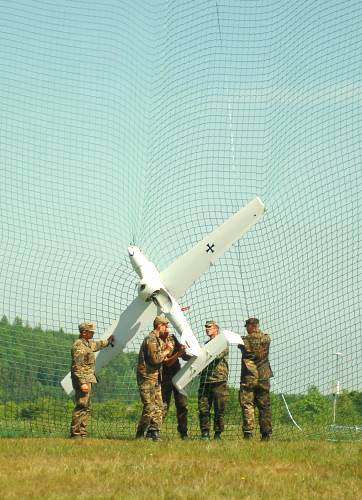Strategic Implications
How Will Germany Use Drones?
Studying the Bundeswehr’s use of drones in Afghanistan over the last 12 years can help to make predictions regarding possible future German drone use, even if such predictions are by nature speculative. In the Afghan theater, the German drones’ main task was to accompany troops on patrol. Drones were also used to monitor hot spots such as known enemy positions, traffic choke points, control posts, etc. Drones provided security for bases and on rare occasions were used to identify and follow individuals. These kinds of missions will remain at the heart of future deployments.
 Public protests notwithstanding, Germany is likely to procure armed UAVs in the future. These systems are likely to be used in similar ways as current ISR systems – troop escorts in particular will remain at the heart of their tasks. Targeted killings of high-level enemies by German armed drones are also possible, but exclusively in the context of an armed conflict (i.e., on a declared battlefield). At this time, it is inconceivable that Germany would follow the U.S. example of targeted killings outside official battlefields. These operations are seen very critically by the German public and within the political realm – so critically that the current government parties noted in their coalition agreement that they “categorically oppose extra-legal killings with drones,” even though they chose not to mention the United States by name.9 Such operations are also unlikely considering German rules for participating in military operations – never alone, always with allies, only if U.N.-mandated – as well as its self-image as a “civilian power.” Last but not least, there is agreement that any military drone operation would have to be mandated by the German parliament, something Minister von der Leyen emphasized in a recent speech:
Public protests notwithstanding, Germany is likely to procure armed UAVs in the future. These systems are likely to be used in similar ways as current ISR systems – troop escorts in particular will remain at the heart of their tasks. Targeted killings of high-level enemies by German armed drones are also possible, but exclusively in the context of an armed conflict (i.e., on a declared battlefield). At this time, it is inconceivable that Germany would follow the U.S. example of targeted killings outside official battlefields. These operations are seen very critically by the German public and within the political realm – so critically that the current government parties noted in their coalition agreement that they “categorically oppose extra-legal killings with drones,” even though they chose not to mention the United States by name.9 Such operations are also unlikely considering German rules for participating in military operations – never alone, always with allies, only if U.N.-mandated – as well as its self-image as a “civilian power.” Last but not least, there is agreement that any military drone operation would have to be mandated by the German parliament, something Minister von der Leyen emphasized in a recent speech:
There is no operation of the Bundeswehr without clear rules on the deployment of weapons. Hence, the deployment of drones by the Bundeswehr is only possible if all legal rules – international as well as national – are being respected, and only after the decision is made by the Bundestag. …The decision about the use [of UAVs], whether in a weaponised role or not is a decision which lies with the German Bundestag.10
That the Bundestag would mandate targeted killings outside of declared battle zones appears inconceivable.
In What Operations Will Germany Use Drones?
Because of its location, Germany is unlikely to ever use military drones in its neighborhood for reasons other than joint training missions. The country is “surrounded by friends,” as the famous dictum (first used by former Defense Minister Volker Rühe) states. Thus drones will be used for expeditionary operations and in the rather unlikely case of territorial defense.
Germany is a risk- and casualty-averse country with a public critical of military engagement. Providing drones to an allied mission instead of troops or manned aircraft is likely to become a preferred way for German politicians to honor Germany’s alliance commitments without risking too much political capital. Past drone deployment plans are a good indicator for this. In February 2003, Germany planned to field LUNAs in Iraq to support the U.N. weapon inspectors monitoring Saddam Hussein’s weapon arsenal; however, the mission was canceled after the U.S. invasion in March 2003.11 Germany had also discussed sending drones to Ukraine.12 Considering these examples, it can be assumed that Germany would be more willing to use drones than manned aircraft for riskier missions and accept a higher danger of them being shot down. Turning this logic around, Germany is likely to see the deployment of drones by other powers as a sign of lesser resolve compared with the sending of manned systems or troops (albeit this assessment would depend on the scale and context of the drone operation).
The regular use of German military drones within its own airspace is unlikely. Because of its historical experiences, the domestic deployment of the military is a contentious topic. Missions in very specific circumstances such as natural disasters are, however, possible. It should also be noted that the aforementioned NATO Global Hawks will, according to NATO, “be able to contribute to a range of missions such as protection of ground troops and civilian populations,” including “border control and maritime safety, the fight against terrorism, crisis management, and humanitarian assistance in natural disasters.”13 Whether this means deployment of the drones within German airspace is unclear.
Impact of Other States’/Non-State Actors’ Drone Use
The use of drones by other actors is a relevant issue for Germany, but not because the country faces any danger from other states’ drones. Germany does not have serious geopolitical rivals or ongoing conflicts; there is hence no direct danger of attack. However, the country is closely monitoring how other states – particularly allies, and specifically the United States – use drones. Political decisionmakers and especially the public are highly critical of U.S. drone operations in Pakistan, Yemen, and Somalia. That these missions are being routed through Ramstein Air Base – and in fact would not be possible without the U.S. base in southwest Germany – is a crucial element of the debate. In May 2015, a Yemeni family that lost relatives in an attack on its village brought a case to court in Cologne, accusing the German government of complicity in the deaths because of the central role of Ramstein.14 The case was dismissed, but it underlined once more the importance of U.S. drone operations for the German debate. It should be noted that while Germany is unlikely to carry out U.S.-type drone missions, the government – like most other European countries – has not officially denunciated the practice.15 Anti-drone groups have furthermore criticized the German secret services for providing the United States with data that can be used for target acquisition.
A foreign drone that intrudes in German airspace is likely to be shot down if deemed a threat and if its destruction would not risk causing harm to people on the ground. The shooting down of an intruding drone is somewhat more likely than the downing of a manned foreign system; both scenarios are, however, unlikely. In a contested territory – i.e., during an allied mission in which Germany participates – an enemy drone is likely to be shot down, but so are manned aircraft.
The reaction to the downing of a German drone by enemy anti-aircraft will depend mainly on the type of drone. The more expensive the drone, the stronger the public reaction is likely to be. Most important will be the question of whether the drone was armed – i.e., whether the enemy is likely to recover missiles carried by the drone and use them for its own operations. Germany may be the fourth-largest arms exporter, but it is terrified by the idea of having German-produced arms fall into the wrong hands and used against it or its allies. Nevertheless, the downing of a drone is unlikely to cause a reaction similar to the response that would follow the downing of a manned fighter and the killing or capturing of its pilot.
German authorities are aware of the danger of drones being used by non-state groups or individuals for terrorist attacks. The ease of using drones for these purposes was demonstrated at an event in 2013 when a member of the Pirate Party (a German opposition party) flew and crashed a commercially available Parrot drone directly in front of Chancellor Angela Merkel and then-Minister of Defense Thomas de Maizière.16 The recent accidental crash of a hobbyist drone on the windshield of a car driving on a German autobahn is another case in point.17 For the time being, there has been no terrorist attack carried out with the help of drones, but the risks are well-understood. Indeed, one of the explicit requirements for the recently procured Medium Extended Air Defense System (MEADS) was its ability to shoot down slow, small, low-flying aircraft – i.e., drones.


 Four of the five types of existing drones are army systems. They are small to midsize, ranging from the hand-launched, less-than-4-kilogram ALADIN to the 170-kilogram KZO. MIKADO is a vertical takeoff quadrocopter system; all other systems are fixed-wing aircraft. All army drones are German products: MIKADO is built by the small German manufacturer AirRobot, KZO by a Cassidian/Rheinmetall joint venture,1 and LUNA and ALADIN are produced in southern Germany by EMT Penzberg. For now, German-built systems are used almost exclusively by the Bundeswehr.2 However, considering Germany’s leading position in machinery export, it is probable that the country’s drone manufacturing and export sector will grow, though it will likely continue to focus on small to midsize drones.
Four of the five types of existing drones are army systems. They are small to midsize, ranging from the hand-launched, less-than-4-kilogram ALADIN to the 170-kilogram KZO. MIKADO is a vertical takeoff quadrocopter system; all other systems are fixed-wing aircraft. All army drones are German products: MIKADO is built by the small German manufacturer AirRobot, KZO by a Cassidian/Rheinmetall joint venture,1 and LUNA and ALADIN are produced in southern Germany by EMT Penzberg. For now, German-built systems are used almost exclusively by the Bundeswehr.2 However, considering Germany’s leading position in machinery export, it is probable that the country’s drone manufacturing and export sector will grow, though it will likely continue to focus on small to midsize drones. Public protests notwithstanding, Germany is likely to procure armed UAVs in the future. These systems are likely to be used in similar ways as current ISR systems – troop escorts in particular will remain at the heart of their tasks. Targeted killings of high-level enemies by German armed drones are also possible, but exclusively in the context of an armed conflict (i.e., on a declared battlefield). At this time, it is inconceivable that Germany would follow the U.S. example of targeted killings outside official battlefields. These operations are seen very critically by the German public and within the political realm – so critically that the current government parties noted in their coalition agreement that they “categorically oppose extra-legal killings with drones,” even though they chose not to mention the United States by name.9 Such operations are also unlikely considering German rules for participating in military operations – never alone, always with allies, only if U.N.-mandated – as well as its self-image as a “civilian power.” Last but not least, there is agreement that any military drone operation would have to be mandated by the German parliament, something Minister von der Leyen emphasized in a recent speech:
Public protests notwithstanding, Germany is likely to procure armed UAVs in the future. These systems are likely to be used in similar ways as current ISR systems – troop escorts in particular will remain at the heart of their tasks. Targeted killings of high-level enemies by German armed drones are also possible, but exclusively in the context of an armed conflict (i.e., on a declared battlefield). At this time, it is inconceivable that Germany would follow the U.S. example of targeted killings outside official battlefields. These operations are seen very critically by the German public and within the political realm – so critically that the current government parties noted in their coalition agreement that they “categorically oppose extra-legal killings with drones,” even though they chose not to mention the United States by name.9 Such operations are also unlikely considering German rules for participating in military operations – never alone, always with allies, only if U.N.-mandated – as well as its self-image as a “civilian power.” Last but not least, there is agreement that any military drone operation would have to be mandated by the German parliament, something Minister von der Leyen emphasized in a recent speech: